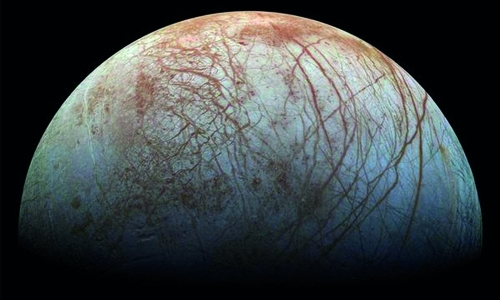Jupiter’s moon Europa shows evidence of water plumes
Paris : A fresh look at data from a 1997 flyby of Jupiter’s moon, Europa, suggests that NASA’s Galileo spacecraft flew directly through a watery plume, raising hopes of probing the jets for signs of life around the second planet from Earth. The revelations Monday came after scientists revisited a puzzling reading from an instrument aboard Galileo, which in 1995 became the first spacecraft to enter the orbit of a gas giant planet.
What they found was the most direct evidence yet of plumes emerging from Europa’s frozen surface, researchers reported in the scientific journal Nature Astronomy. Europa has long been thought to cover a salty ocean about twice the size of our planet’s.
Given the suspected abundance of warm, liquid water under its thick ice shell, the moon is considered a “top candidate” by NASA for life on a solar system body other than Earth.
In the last several years, NASA’s Hubble Space Telescope has detected evidence of plumes on Europa, but from afar. Galileo came much closer during its 11 flybys of Europa. “On one particular pass by Europa, the spacecraft came very, very close to the surface -- as I remember less than 150 kilometres (93 miles) above the surface -- and it was on that pass that we saw signatures that we never really understood,” said Margaret Kivelson, professor emerita of space physics at the University of California, Los Angeles, on NASA TV.
That region was in an area where the Hubble Space Telescope had spotted repeated evidence of plumes. When another researcher presented findings recently on Hubble’s collection of observations, “that led us to realize we had to go back and look at Galileo data,” said Xianzhe Jia, associate professor at the University of Michigan, Ann Arbor.
For the new study, experts measured variations in the moon’s magnetic field and plasma waves, based on data obtained during Galileo’s close flyby, and found they were “consistent” with the spacecraft crossing a plume. “These results provide strong independent evidence of the presence of plumes at Europa,” they wrote in Nature.
The team reconstructed the spacecraft’s path to pinpoint the plume’s location on the moon’s surface. “These findings will help plan future missions to Europa, such as NASA’s Europa Clipper and ESA’s Jupiter Icy Moons Explorer spacecraft, both of which are expected to arrive at Jupiter between the late 2020s and early 2030s,” said a Nature summary.
Related Posts

